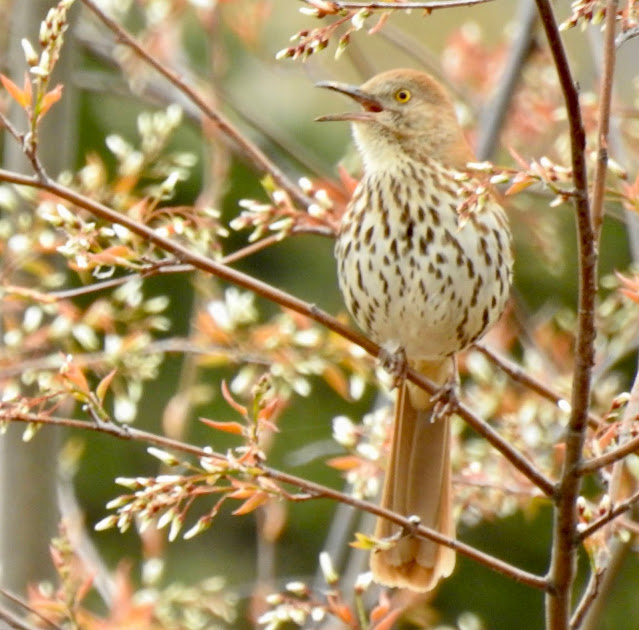On May 2 we were walking our dogs on a vacant court near our home in Fredericton on a beautiful sunny day. This has been an early spring and the Amelanchiers were already in bloom. I became aware of loud, intense bird song on my left over a tangle of blackberry and raspberry canes with a hedgerow of bushes beyond. I could tell it was a mimic, one of our 3 species which produce long, varied, repetitive bird songs. I describe them as loud and boisterous.
The Brown Thrasher, along with the Gray Catbird and the Northern Mockingbird are members of the Mimidae family. There are 34 species in 11 genera worldwide in that family. In North America there are 10 species and all live in the southwest except the Brown Thrasher, the Gray Catbird and the Northern Mockingbird. We have the Gray Catbird as a common summer resident. The Brown Thrasher and the Northern Mockingbird are listed as rare summer residents. These three species prefer thickets, hedgerows and grown-over areas. Brown Thrashers and Northern Mockingbirds like to sing from a high perch and they certainly make their presence known. The Gray Catbird is boisterous and noisy but it usually hides in thick vegetation.
Brown Thrashers have a long decurved bill with which to probe for food in leaf litter and holes in the ground. They feed on insects, seeds and invertebrates. They have the distinctive orange/yellow eye of the thrasher family. The Brown Thrasher is a beautiful rufous brown and the long tail is very noteworthy. It is a large bird, 29 cm (11.5 in) long.
Brown Thrasher Singing from an Amelanchier BushMale and female Brown Thrashers are similar in appearance. The rufous brown colour and the stripes on the breast and flanks are striking.
The family Mimidae are noted for their boisterous, repetitive songs. One can actually use the repetitive characteristics of the song to identify the species. That is helpful in identifying species that like to spend their time in thick vegetation! As I listened to the song of the bird mentioned in this post I was immediately aware it was a 'mocker' (member of Mimidae). Here in NB that would make it either a Gray Catbird, a Northern Mockingbird or a Brown Thrasher. I could tell right away it was not a catbird because I am most familiar with that song. So the test then, since I could not see the bird at first, was was it a mockingbird or a thrasher. One can tell, although it is not as easy as described in the literature, by the number of repetitive elements in each repetitive phrase. These phrases are intermingled with many other warbles and twitters so one has to listen carefully. I could eventually tell there were usually 2 repetitive elements in the phrases, so that would make the bird a Brown Thrasher. The Northern Mockingbird usually has 3 repetitive elements in each repetitive phrase. So the task then was to wade through the blackberry and raspberry canes and to try and see the singing bird. I eventually found it sitting near the top of the high bushes blended in very well with the blossoms. What a sight - what a beautiful bird. It continued to sing. I stayed well back and just enjoyed the concert. It allowed the photos seen above.
Brown Thrashers are amazing songsters. They have the largest repertoire of songs of all North American songbirds. They are able to vocalize 3000 distinct songs! They sing for long periods at a time interspersed with rest periods.
Brown Thrashers are the state bird of Georgia. They have inspired the National Hockey League team, the Atlanta Thrashers, to use their name.
For more information on the life history of this species, search this blog for 'Brown Thrasher'.


Back in the 70"s we had one nesting in a thick stand of berry bushes in Mazerolle settlement. It was so wonderful. Have not seen one since then. Congrats on your find. June
ReplyDelete